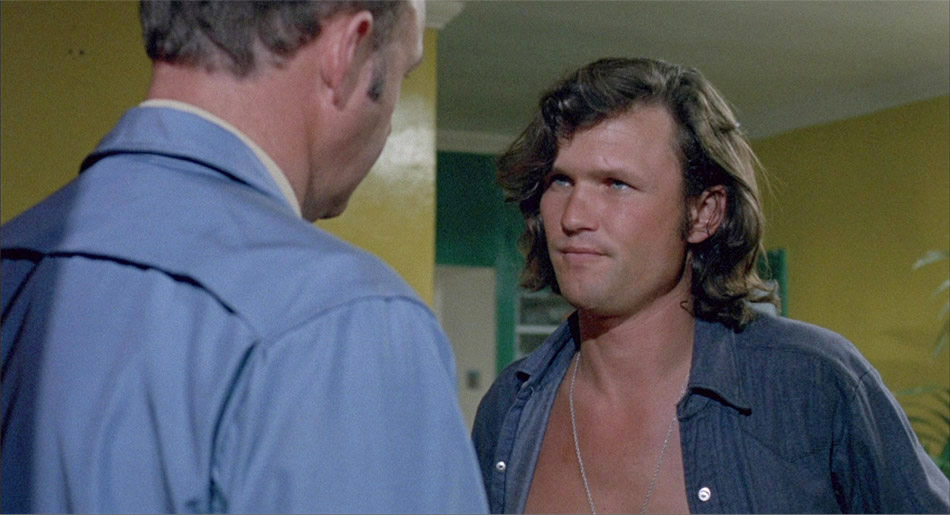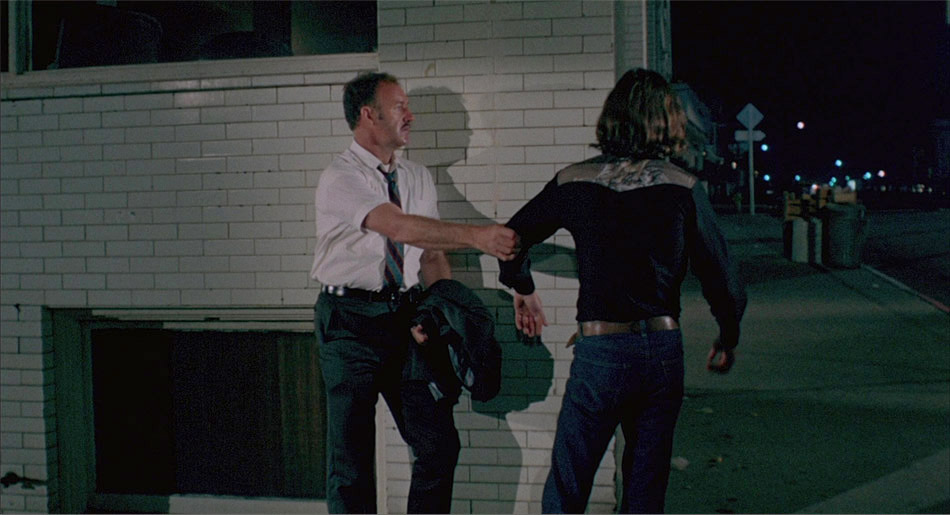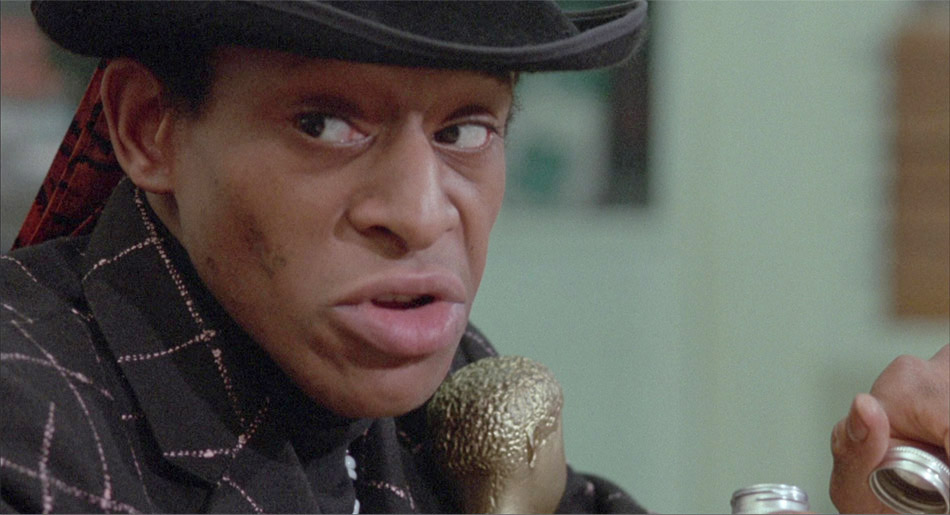| |
“…a moody, melancholy little film whose strength lies in its evocation of the rootless, aimless, irresponsible life-style of the pop/drug culture. The film also owes a great deal to Kris Kristofferson’s sad little songs and even more to his amiable personality.” |
| |
Brenda Davies, Monthly Film Bulletin, May 1972 |
Note: I’m currently on a six-day week, long hours job with many other things demanding my attention in what’s facetiously known in this household as ‘spare time’ so my apologies for the lateness of this review.
Down to his last few bucks, ex-drug pusher and has-been pop idol Cisco Pike returns to a well-frequented pawnshop and greets an old friend behind the counter. He’s there to sell his famous guitar, autographed by pop legends but his friend turns down the offer because he knows it’s Pike’s guitar, a rather moving and intelligent act of friendship. Pike returns to his Yoga-practising girlfriend in a small Venice Beach studio in run down Los Angeles. A narcotic division cop calls in and badgers Pike to travel with him to a garage stuffed with bricks of high-grade marijuana. The cop demands that Pike uses his resources to sell as much as he can to get $10,000 in under three days for reasons the cop doesn’t divulge. Pike has no choice but to dive back in to the murky underbelly of Los Angeles and offload as much of the grass as he can as the deadline looms…

Sharing its slacker DNA with the rather wonderful Two Lane Blacktop, Cisco Pike is an unusual character driven film with its own charm courtesy of its lead. It’s Kristofferson’s first major role which coincided with his writing and singing career gearing up a notch. When I first caught sight of clean-shaven Kristofferson in this film (at the age of 36) I was struck by how much young Jeff Bridges’ DNA he shares and also how welcome a beard would be on some men’s faces. To me, the double-K was always Ellen Burstyn’s sensitive and bearded lover in Scorsese’s masterful Alice Doesn’t Live Here Anymore. He carried the facial hair over to A Star Is Born and kind of owned it ever since. His floppy long fringe hair, forever out of control, is always being pushed back (it’s almost a separate character) and his whip thin, rangy frame with optional six pack abs means that he acts a lot with shirt unbuttoned or absent. Director Norton knows the cinematic value of beautiful, bare skin. Karen Black as Sue, Pike’s girlfriend, had a very solid career having just earned an Oscar nomination for Bob Rafelson’s superb Five Easy Pieces. Even though Black’s presence in my memories of 70’s cinema is one of great ubiquity, I’m having trouble recalling the definitive Black performance although her Rayette in Pieces comes pretty close. The nominal ‘star’ of the film and first billed is one of America’s most feted actors, a man whose threat emanates off him especially when he’s smiling. But in 1971, Gene Hackman’s defining role and indeed defining movie had just opened in the US a month before Cisco Pike. Both films started shooting in November 1970 (Pike on the 1st November, The French Connection on the 30th) so you might say that his narc cop Leo Holland was a dry run for the iconic ‘Popeye’ Doyle, the anti-hero of one of the greatest cop movies of all time. It’s curious to me how hard some critics have been on Hackman’s performance but I think that’s more to do with the character. He’s a one-note, disgruntled, paranoid soul who uses violence and intimidation to strike back at a world he feels has beaten him down. It’s not a meaty role and he’s barely in the film but he certainly registers.
Among the supporting cast are quite a few stand-outs. In just the one scene Roscoe Lee Brown playing the pawn shop owner radiates compassion and friendship for a man down on his once considerable luck. His was a well-known face in 70s film and TV scene and for some reason a very reassuring one. And look who’s playing Pike’s once singing partner, Jesse… We are so used to latter day Harry Dean Stanton performances, we often forget he was also a young actor. We meet him in Pike’s bath, high as a kite but still the men’s friendship shines through. The man forever associated with the L.A. underworld’s cutest nickname, ‘Huggy Bear’, Starsky and Hutch’s hip informant, is Antonio Fargas as Buffalo, a fellow drug pusher and one of Pike’s competitors. With those amazing eyes and such a distinctive face, he’s instantly recognisable and of course, cool just oozes out of him. Rich girl Mina is played by one of a handful of actors who go by just the one name, Viva. Famous for being the star in many Andy Warhol art films, she brought an improvisational flair to her scenes and takes part in a threesome with Kristofferson which must go down in movie lore as being the shortest ‘sex scene’ in film history, lasting all of 6 seconds. Before you’ve registered what you’re watching, it’s gone. The other participant in this scene is by far the most interesting ‘bit’ actress in the film, Joy Bang playing Lynn, justly celebrated in the extra features. Some actors have charisma, and some have aspects of their look and personality that the camera adores. For all of the smallness of the part, Bang ticks both of those boxes. Like Rosanna Arquette in the same era, I found my attention focusing on whatever she was up to in the frame. 60s activist Wavy Gravy turns up in his original incarnation as Hugh Romney playing Reed, a dope acquiring driver and as I would only recognise him from a documentary I worked on twenty years ago, I have to credit research for being this well informed.

Technically, the film is directed and shot with a somewhat invisible technique sometimes saddled with era defining tropes like zooms and a few handheld shots added to the mix. Shots never call attention to themselves and director Norton and his cinematographer Vilis Lapenieks trust in the narrative and the performances enough to go easy on the camera moves. Of course, there are practical reasons for shooting a movie ‘straight’ both of which of course are time and money but it’s a style that suits the story and that’s important. Editor Robert C. Jones’ work is also invisible which is just as it should be (except perhaps in the cut of Kristofferson crossing a bridge going from one green/grey car passing him by to a red VW beetle completing the wipe before Kristofferson’s credit). There’s no traditional score per se, just songs from Kristofferson and a few others. These are effective mood setters and sometimes coincide with the images in ways that seem unforced and may even be accidental. The line “…and a problem when he’s stoned,” comes over a hand held high angle pan following Pike’s car but the dominant image in the foreground is… uh, a stone! It must be those falling rocks Pike warned Buffalo about. Whether you respond to the Kristofferson songs is a personal thing and while strictly not a fan of his music, I did appreciate the skill in the lyrics and the easy, laid back voice taking me through Pike’s journey.
Cisco Pike deserves to be on the list of overlooked works that really deserves a wider audience but nestles happily in cult status where its cool can be enjoyed in a much more concentrated form. Far out.
Cisco Pike is presented in the 1.85:1 aspect ratio with the correct thin letterboxing on 16:9 TVs. Early 70s cinema has that same film look about it and it’s very easy to wallow in nostalgia. But it took and takes some effort to scrub up a film print even with the sophistication of today’s software. Given the film’s relative obscurity, it’s a joy (as opposed to a Joy Bang) to report that the film looks terrific with barely any dirt or scratches and the welcome film grain hardly noticeable.
The mono soundtrack showcases Kristofferson’s melancholy songs and all the dialogue is crystal clear.
There are new and improved English subtitles for the deaf and hard-of-hearing.
Audio commentary with writer-director Bill L. Norton and film historian Elijah Drenner (2020)
Norton went to the University of California Los Angeles, a place in my late teens that was an unreachable Mecca to this film nut who just could not convince anyone in the near-minus number of true film schools of the UK in the late 70s to take me on. Drenner is knowledgeable and a very good moderator. The chat is never dull and is full of personal stories. Venice Beach in L.A. has somewhat since been gentrified. At the time of filming, it was known as ‘Slum by the Sea’. The two discuss the obvious parallels between Kristofferson and Pike (minus the drugs, one imagines if you don’t count tobacco and alcohol which curiously few people ever do). Kristofferson used a rolled up magazine to poke Hackman in a many taken scene leading to Hackman losing his rag. The film was greenlit by Columbia bigwigs who simply did not understand how their company had made a small fortune with Easy Rider.

I was very surprised to hear that director Norton was “miserable making the film, as I didn’t know what I was doing…” I have directed a few times and I have to say that misery was so far from my experience, I’m shocked to hear it could have been otherwise for other people. Why want to do one of the most exciting jobs in the world and be miserable? He was 27 at the time so I guess a certain amount of callow inexperience coloured his time behind the camera. For some reason the bit part actress celebrated in another extra, Joy Bang (yeah, I know but it’s her real name), disappeared during a pivotal scene and never came back. There’s a lovely quotation from producer Gerald Ayres to finish the commentary delivered by Drenner.
Walking Contradictions – Cisco Pike: Then and Now (2020): documentary revisiting the film’s Los Angeles locations (9’ 53”)
Normally such compare and contrast locations then and now documentaries are a little dry. This one is a surprising and entertaining blast down principally to the diary nature of the commentary moderator Elijah Drenner whose relationship to the city seems as profound as the director’s own. It’s good fun. Drenner is obviously emotionally invested in his subject something that shines through.
Ode to Joy (2020): film programmer and writer Kier-La Janisse explores the life and career of actor Joy Bang (42’ 56”)
Every bit actor should have such a fan. Janisse gives a piece-to-camera essay on the film career of Joy Bang (a legitimate name by the way, it’s her married name though I may have gone with my maiden surname ‘Wener if I wanted less bang for the buck). Some actors inspire such interest, devotion and passion and even after such a brief role in Cisco Pike, you can see that twinkle in her eye that marked her out for special attention. Bang’s life – and she’s still with us – is an entertaining romp through Hollywood in the early 70s and Janisse shows her appreciation with some style. The 2016 article I suspect the presentation is based on can be found here:
http://www.spectacularoptical.ca/2016/01/the-big-bang-the-too-short-career-of-actress-joy-bang/

Image gallery: publicity and promotional photography
This features the following: 7 black and white publicity shots, 1 colour, 1 colour triptych, 1 front-of-house colour still and 9 collage front-of-house stills that make the film look like a sex romp. Finally, there are 3 poster designs.
Original theatrical trailer (2’ 51”)
Featuring a good chunk of the first scene to Kristofferson’s music (a canny move as his star was definitely shining and rising in 1972), the trailer features a graphic signature of repeating the actors’ names. No idea why that was thought to be particularly effective. This trailer may have stirred my interest but perhaps not as an 11 year-old in 1972.
TV spot (30”)
A cut down of the trailer and a battered copy either rust filtered or colour bled with age. It uses the same graphic elements of the trailer too.
Limited edition exclusive 40-page booklet with a new essay by Christina Newland, the original soundtrack EP liner notes, an archival interview with Kris Kristofferson, Stephen Farber’s 1972 article on Cisco Pike, an overview of contemporary critical responses, and film credits
Christina Newland’s It Ain’t Fun No More gives us a précis of the plot (and it’s comprehensive so keep clear until you’ve seen the film) and a few insights to noteworthy aspects of the film, namely the theme of disillusionment coming out of the optimistic 60s. Cisco Pike: The Soundtrack tells of the EPs released to promote the film and Kristofferson’s music. The liner notes are reprinted and very keen to make you believe the film is an ‘adventure’. The last paragraph describes Kristofferson’s ascent in film and his link with Taxi Driver. The six subsequent Notes on the piece are enlightening too. Kris Kristofferson; walking contradiction is an interview with the actorby Corinne Musgrave written in 1972 to promote the film. Here we find out a little more about Kristofferson (the English degree from Oxford, the piloting helicopters, all the good stuff) and his music. He seems to be the most remarkable of men refunding the audience of one concert where he thought he put on a bad show. Cisco isn't just another dope movie by Stephen Farber is a 1972 New York Times piece on how well Norton got the characterisation of a fading music star just right and how he managed to evoke the slums and mansions of Los Angeles as a sprawling city, the host to the demise of 60’s optimism. Critical Response features an extract from the Monthly Film Bulletin’s review at the time. Not that it matters but I had not read the booklet before posting my opening quote, the result of being left a huge vintage collection of Monthly Film Bulletins from 1965 to when the reviews were incorporated into Sight and Sound, the BFI’s flagship film magazine in 1990. The second and last extract is from Tom Vito’s review for the Washington Post. On page 38 there’s a poster design that really doesn’t know what the hell is going on with six Hackmans, four with his gun drawn.
Cisco Pike is a fascinating film with a charismatic lead performance from Kristofferson, interesting work from all the rest of the cast with a nascent Popeye Doyle waiting in the wings. It’s also quite a thoughtful character piece with a laid back style and a melancholy air that deserves a little more attention that it garnered at its own cinematic birth. Well recommended.
|